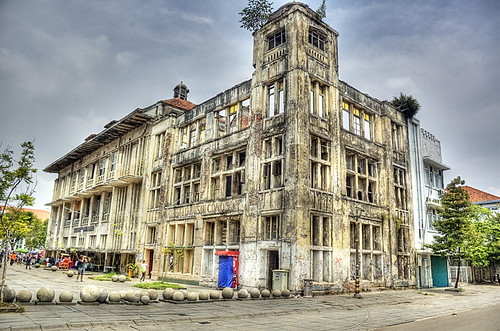Time is the justice that examines all offenders. >Shakespeare
With evidence mounting that parts of North Jakarta are sinking fast (*), I decided to check out the old Dutch quarters of the city before it’s too late.
To get there, I took my chances on Jakarta’s now infamously dangerous busway and the lunatic bus driver made a couple of very close calls as he trashed his red-colored potential death-machine through the gears like Michael Schumacher on race day.
But it was worth the effort: a visit to this forlorn part of Jakarta really is a journey back in time and there are a surprisingly large number of very old buildings still there – even though many of them look like they could literally collapse AT ANY MOMENT:
Quite why the developers haven’t moved in and simply flattened the whole place for redevelopment is something of a mystery, but I’ve been told it’s because impossibly unwieldy bureaucracy has prevented any development from taking place.
Saved by red tape, you could say. At least until the whole place either sinks or collapses.
A short walk from the Fatahillah Square - where the Dutch used to execute prisoners in all sorts of wonderfully gruesome ways - is the Kali Besar Canal.
And my God do the canal’s turdgid waters stink! It’s like you’ve gone to the bog after someone with a nasty bout of the dreaded Bali Belly has just had a dump! Shit, it’s so bad even the rats can’t stand it here!
But along the road which runs parallel to the canal are some of the most notable colonial buildings in Indonesia – most of them being former palaces or houses dating from the 18th century.
Probably the most interesting is Toko Merah (Red Shop):
 Toko Merah as it stood over 70 years ago...
Toko Merah as it stood over 70 years ago...
 ...and as it stands today.
...and as it stands today.
The origins of Toko Merah date back to 1730 when it was build by the order of the Dutch to serve as the residence of the then Governor General Baron Van Imhoff. Interestingly, the building doesn’t have a canopy attached to the front like the other Dutch buildings on this street (to provide pedestrians with shelter from the sun), since it was constructed before the regulation making this a requirement came into effect.
The building got its present name “Red Shop” after a Chinese businessman named Oey Liauw Kong turned it into a store in the 1850’s, although it is now owned by state-owned company PT Perusahaan Dagang Indonesia, but has been left unoccupied since 2000.
A bit further along the street, and one of the old Dutch buildings has been turned into a nightclub called the Athena – which in keeping with the shabby character of its surroundings, is said to be a very dark and degenerate sort of place (if you know what I mean), but no doubt providing good custom for the wonderfully designed Batavia Hotel close by.
Then, right at the end of the street, there’s the bizarrely named Chicken Market Bridge (in reference apparently to a once nearby poultry market), which takes you across the canal:
 Chicken Market Bridge with the Batavia Hotel in the background (picture taken in RAW and processed into a pseudo HDR image)
Chicken Market Bridge with the Batavia Hotel in the background (picture taken in RAW and processed into a pseudo HDR image)
The bridge is over 350 years old and operated as a drawbridge when boats, many eons ago, came up the canal from the nearby Sunda Kelapa Harbor. Interestingly for Brits, the bridge was at one time called Engelsebrug (English bridge) as it connected the compounds of the rival English (on the west side) and Dutch on the other (the east side).
Hell, all this history and all these old, crumbling buildings. Nope, nothing lasts for ever and permanence is just an illusion. Look up at the stars and they appear unshakably solid, but the reality is they are moving away at great speeds, eventually to fizzle out and become dark, cold bodies.
Whether or not these old colonial buildings in Kota have any relevance for modern-day Jakarta people is a moot point. Personally I think they do.
And especially if North Jakarta is destined to become the new Venice of Asia!
 *Yep, Jakarta is sinking and rapidly too. In a study conducted by researchers from the Bandung Institute of Technology, it was found that land in some parts of central Jakarta around Monas had sunk by around 10-12 cm over the last eight years, mainly due to massive extraction of groundwater.
*Yep, Jakarta is sinking and rapidly too. In a study conducted by researchers from the Bandung Institute of Technology, it was found that land in some parts of central Jakarta around Monas had sunk by around 10-12 cm over the last eight years, mainly due to massive extraction of groundwater.
Other parts of Jakarta fared even worse – land in Muara Baru, North Jakarta, and Cenkareng, West Jakarta, has sunk an incredible 116 centimeters in the same period! Time to think about ditching the filthy bajaj and exchanging them for Gondolas, lads!!!








Comments
Post a Comment